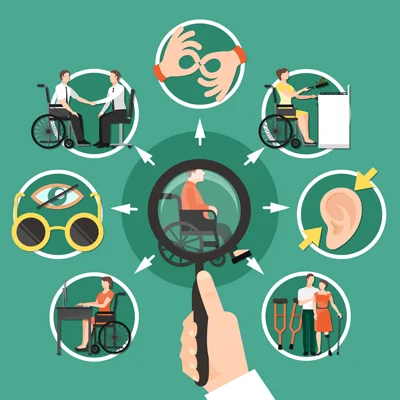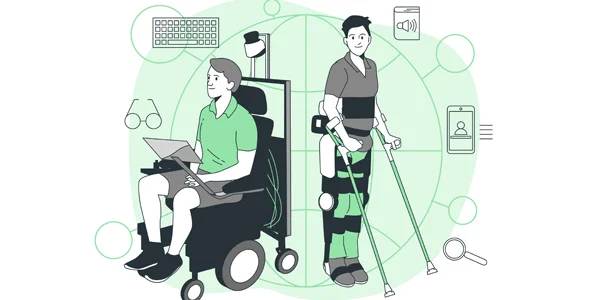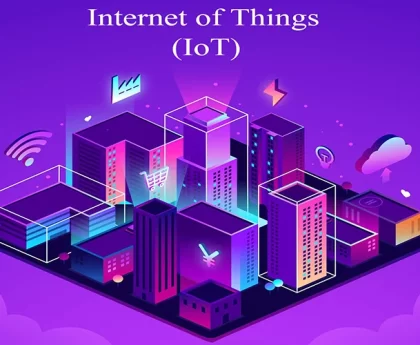Assistive Technology: Workplace Promoting Diversity and Inclusion refers to a wide range of tools, devices, software, and equipment designed to assist individuals with disabilities in their daily activities and tasks. The primary purpose of assistive technology is to enhance the quality of life, independence, and overall functioning of people with disabilities. These technologies can address various types of impairments, including physical, sensory, cognitive, and communication disabilities.
Types of Assistive Technology
Assistive technology encompasses a wide range of tools and devices designed to assist individuals with disabilities. These technologies are categorized into various types, depending on the specific needs they address.
Here are some common types of assistive technology:
- Mobility Aids:
– Wheelchairs and power wheelchairs
– Scooters
– Walkers
– Canes
– Crutches
– Transfer boards and assistive lifts - Communication Aids:
– Augmentative and Alternative Communication (AAC) devices
– Speech-generating devices
– Communication boards and books
– Text-to-speech software and apps - Visual Aids:
– Screen readers
– Screen magnification software
– Braille displays and embossers
– Optical character recognition (OCR) software
– Electronic magnifiers - Hearing Aids and Assistive Listening Devices:
– Hearing aids
– Cochlear implants
– FM systems
– Amplified telephones
– Captioned telephones - Environmental Control Systems:
– Home automation systems to control lights, thermostats, and appliances
– Voice-activated smart home devices
– Switch control interfaces - Adaptive Computer Hardware and Software:
– Keyguards and keyboard overlays
– Alternative input devices (e.g., trackballs, touchpads, sip-and-puff devices)
– Screen-reading software
– Speech recognition software
– On-screen keyboards - Cognitive and Learning Aids:
– Text-to-speech software
– Word prediction software
– Graphic organizers and mind mapping tools
– Audiobooks and e-books with text-to-speech features - Braille and Tactile Aids:
– Braille notetakers
– Refreshable Braille displays
– Tactile graphics and 3D printing for educational materials - Adaptive Sports and Recreation Equipment:
– Adaptive bicycles and tricycles
– Wheelchair-accessible sports equipment
– Assistive devices for adaptive skiing and other sports - Daily Living Aids:
– Adaptive utensils and kitchen tools
– Medication management devices
– Assistive devices for dressing, grooming, and personal care - Prosthetics and Orthotics:
– Prosthetic limbs
– Orthopedic braces and supports
– Custom orthotic insoles - Assistive Apps and Software:
– Mobile apps for a variety of purposes, such as note-taking, navigation, and organization
– Communication apps for text and speech output
– Educational and learning apps for different disabilities
These are just some examples of the types of assistive technology available to support individuals with disabilities. The choice of assistive technology depends on an individual’s specific needs and the nature of their disability.

Facts of Assistive Technology
Certainly, here are some facts about assistive technology:
- Assistive Technology Empowers Independence: Assistive technology plays a crucial role in enhancing the independence and quality of life for individuals with disabilities. It allows them to perform daily tasks and activities that may be otherwise challenging or impossible.
- Varied Applications: Assistive technology is not limited to a specific disability or condition. It can address the needs of individuals with physical, sensory, cognitive, and communication disabilities. From mobility aids to communication devices, there is a wide range of applications.
- Legal Protections: In many countries, including the United States, there are legal requirements that mandate access to assistive technology in certain contexts, such as the Americans with Disabilities Act (ADA). These laws aim to ensure that people with disabilities have equal opportunities and access to technology.
- Constant Technological Advancements: Assistive technology continues to evolve with advancements in technology. Innovations such as brain-computer interfaces, exoskeletons, and smart home automation systems have the potential to further improve the lives of individuals with disabilities.
- Customization: Assistive technology solutions are often highly customizable to cater to individual needs. They can be tailored to address specific challenges and can be adjusted as an individual’s needs change.
- Cost and Accessibility: While some assistive technology can be expensive, there are also low-cost and open-source solutions available. Advances in technology have made certain types of assistive technology more affordable and accessible.
- Educational Applications: Assistive technology is commonly used in educational settings to support students with disabilities. It can include screen readers, communication devices, and software to help with reading, writing, and math.
- Improved Communication: Communication aids, such as Augmentative and Alternative Communication (AAC) devices, provide a means for individuals with speech or language impairments to express themselves effectively, thereby enhancing their social interaction and participation.
- Assistive Technology and the Workplace: Many individuals with disabilities use assistive technology to succeed in the workplace. It helps with tasks such as typing, reading, and using computers, making it easier for them to be employed in various professions.
- Global Impact: Assistive technology is not limited to a particular region or country. It has a global impact and is used by people with disabilities worldwide to improve their daily lives.
- User-Centered Design: Effective assistive technology design involves close collaboration with users and experts to create solutions that truly meet the needs and preferences of individuals with disabilities.
- Non-Disability-Specific Applications: Some assistive technology, such as voice recognition software and screen magnifiers, has applications beyond the disability community. They are also used by individuals without disabilities for convenience and productivity.
- Research and Development: There are ongoing research and development efforts to create more advanced and effective assistive technologies. These efforts are aimed at making AT even more user-friendly and responsive to users’ needs.
- A Bridge to Inclusion: Assistive technology helps bridge the digital divide and promotes inclusion by ensuring that people with disabilities can access and benefit from technology in education, employment, and everyday life.
These facts highlight the importance and impact of assistive technology in improving the lives of people with disabilities and promoting inclusivity in society.
Benefits of Assistive Technology
Assistive technology offers numerous benefits to individuals with disabilities, as well as to the broader community.
Here are some key advantages of using assistive technology:
- Enhanced Independence: Assistive technology empowers individuals with disabilities to perform daily tasks and activities independently. This increased autonomy can lead to greater self-confidence and a higher quality of life.
- Improved Access to Information: Assistive technology, such as screen readers and text-to-speech software, provides individuals with visual impairments access to digital content, books, and information on the internet, allowing them to stay informed and engaged.
- Communication Support: Communication aids, including AAC devices and speech-generating software, help individuals with speech and language disabilities express themselves, communicate with others, and participate in social interactions.
- Increased Mobility: Mobility aids like wheelchairs, scooters, and adaptive transportation devices enable people with mobility impairments to move around and access various environments, both indoors and outdoors.
- Enhanced Learning Opportunities: Assistive technology in education facilitates learning for students with disabilities. It includes tools and software that help with reading, writing, math, and organizational skills.
- Greater Employment Opportunities: Assistive technology can enable individuals with disabilities to access employment opportunities by providing tools that accommodate their specific needs, such as screen readers, speech recognition software, and ergonomic workstations.
- Improved Safety and Health: Assistive technology, such as alert systems and home automation, can enhance safety and support daily living tasks, reducing the risk of accidents and promoting overall well-being.
- Access to Entertainment and Recreation: Individuals with disabilities can enjoy entertainment and recreational activities, thanks to adaptive gaming consoles, audiobooks, and other assistive technology designed for leisure.
- Equal Participation in Society: Assistive technology helps level the playing field, ensuring that individuals with disabilities can participate fully in social, cultural, and community activities.
- Customization and Adaptability: Assistive technology solutions can be customized to meet individual needs, allowing for a tailored approach that adapts to changing requirements.
- Promotion of Inclusion: By facilitating access to technology and information, assistive technology promotes the inclusion of individuals with disabilities in various settings, such as education, the workplace, and social gatherings.
- Enhanced Productivity: Many assistive technology tools can increase productivity by providing alternative means of input and output. This can be beneficial for both work and personal tasks.
- Reduction of Barriers: Assistive technology reduces barriers and challenges faced by individuals with disabilities, making it easier for them to engage with the digital world, access public spaces, and communicate effectively.
- Improvement in Quality of Life: Overall, assistive technology can significantly enhance the quality of life for individuals with disabilities, making daily living more manageable and enjoyable.
- Support for Caregivers and Families: Assistive technology can ease the caregiving burden by automating certain tasks and providing tools that support individuals with disabilities, helping to create a more balanced family dynamic.
- Global Impact: Assistive technology is not limited to a specific region or country; it has a global reach, benefiting people with disabilities worldwide.
These benefits illustrate the transformative impact of assistive technology in enabling greater inclusion, independence, and opportunities for individuals with disabilities.

How does assistive technology help us in our daily life?
Assistive technology plays a significant role in improving the daily lives of individuals with disabilities by addressing specific challenges they may face.
Here’s how assistive technology helps in our daily lives:
- Enhanced Independence: Assistive technology empowers individuals to perform daily tasks and activities on their own, reducing their reliance on caregivers or others for assistance.
- Improved Communication: Communication aids like speech-generating devices and AAC apps enable individuals with speech or language impairments to express themselves, engage in conversations, and participate in social interactions.
- Access to Information: Screen readers, text-to-speech software, and Braille displays make digital content, books, and information on the internet accessible to individuals with visual impairments, fostering learning and staying informed.
- Mobility and Accessibility: Mobility aids such as wheelchairs, walkers, and scooters enhance physical mobility, allowing individuals with mobility impairments to navigate both indoor and outdoor environments with greater ease.
- Safety and Health: Assistive technology can improve safety by alerting individuals to potential hazards, providing reminders for medication management, and promoting overall well-being.
- Education and Learning: Assistive technology tools, including text-to-speech software, note-taking apps, and specialized learning apps, support students with disabilities in their educational pursuits.
- Employment Opportunities: Assistive technology in the workplace, such as screen readers and speech recognition software, helps individuals with disabilities access employment opportunities and perform job-related tasks.
- Daily Living Tasks: Adaptive equipment for daily living, such as utensils and dressing aids, simplifies daily tasks like eating, dressing, grooming, and personal care.
- Recreation and Leisure: Adaptive gaming consoles, audiobooks, and specialized recreational equipment enable individuals with disabilities to enjoy entertainment and leisure activities.
- Accessibility in the Digital World: Assistive technology ensures that individuals with disabilities can access and use computers, smartphones, and other digital devices effectively, enabling them to connect with the digital world.
- Customization and Adaptability: Assistive technology solutions can be tailored to meet an individual’s specific needs and can be adjusted as those needs change over time.
- Inclusion in Society: Assistive technology promotes the inclusion of individuals with disabilities in various aspects of society, including education, employment, and social and cultural activities.
- Improved Productivity: Many assistive technology tools can increase productivity by providing alternative means of input and output, which can be valuable for work, education, and personal tasks.
- Support for Caregivers: Assistive technology can reduce the caregiving burden by automating certain tasks and providing tools that support individuals with disabilities, creating a more balanced family or caregiving dynamic.
- Global Impact: Assistive technology is not limited to a particular region or country; it has a global reach, benefiting people with disabilities worldwide.
In summary, assistive technology greatly enhances the daily lives of individuals with disabilities by fostering independence, improving access to information and communication, facilitating mobility and accessibility, and promoting inclusion in various aspects of life. It also has the potential to improve the lives of caregivers and family members who support individuals with disabilities.
What is the role of assistive technology in education?
Assistive technology plays a vital role in education by providing students with disabilities the tools and support they need to access educational opportunities, engage in learning, and achieve their academic potential.
Here are the key roles of assistive technology in education:
- Access to Curriculum: Assistive technology helps students with disabilities access the same educational content as their peers. This includes reading materials, textbooks, digital resources, and instructional materials in various formats.
- Alternative Means of Communication: For students with speech and language disabilities, assistive technology, such as AAC devices and speech-generating software, provides a means to express themselves and actively participate in class discussions.
- Support for Reading and Writing: Assistive technology tools like text-to-speech software, screen readers, and speech recognition software assist students with dyslexia, visual impairments, or writing difficulties in reading and producing written content.
- Organization and Time Management: Students with attention and organizational challenges benefit from assistive technology that helps them manage their schedules, assignments, and tasks. These tools can include task managers and digital calendars.
- Math Assistance: There are assistive technology solutions designed to assist students with disabilities in math, such as digital graphing calculators, equation-solving software, and accessible math notation tools.
- Enhanced Note-Taking: Assistive technology aids students in taking notes, such as digital note-taking apps and voice recognition software, which can be particularly valuable for those with fine motor difficulties.
- Accessible Tests and Assessments: Educational technology can provide accommodations during assessments, ensuring that students with disabilities are assessed on their knowledge and skills rather than on their disability-related challenges.
- Customized Learning: Assistive technology allows for personalized learning experiences, tailoring content and pace to meet the individual needs and learning styles of students.
- Inclusive Classrooms: Assistive technology fosters inclusivity by enabling students with disabilities to participate fully in general education classrooms alongside their non-disabled peers.
- Professional Development: Educators receive training in assistive technology to effectively integrate these tools into their teaching methods and to accommodate students with disabilities.
- Transition Planning: Assistive technology can support students with disabilities in transition planning, helping them prepare for post-secondary education and employment opportunities.
- Higher Education and Beyond: Assistive technology is not limited to K-12 education; it also plays a crucial role in higher education, where students with disabilities can access educational materials and resources to succeed in college and university programs.
- Research and Innovation: Assistive technology continues to evolve with ongoing research and innovation, providing more effective and user-friendly solutions to support students with disabilities.
Overall, the role of assistive technology in education is to remove barriers and provide equal access to educational opportunities, promote inclusivity, and empower students with disabilities to reach their full academic potential. It enhances the overall learning experience for all students, regardless of their abilities, and supports a more inclusive and equitable educational environment.
Internet of Things: (IoT) Benefits & Building The Urban Future





